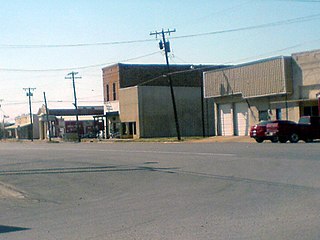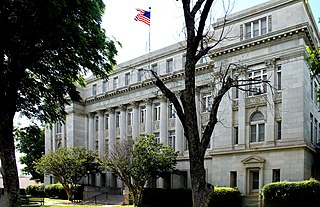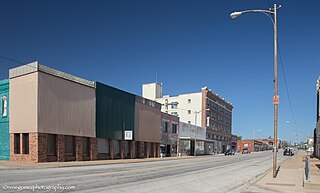
Ranger is a city in Eastland County, Texas, United States. The population was 2,468 at the 2010 census. Ranger College, a community college, is the second-largest employer in the community.

Wichita Falls is a city in and the county seat of Wichita County, Texas, United States. It is the principal city of the Wichita Falls Metropolitan Statistical Area, which encompasses all of Archer, Clay, and Wichita Counties. According to the 2010 census, it had a population of 104,553, making it the 38th-most populous city in Texas. In addition, its central business district is 5 miles (8 km) from Sheppard Air Force Base, which is home to the Air Force's largest technical training wing and the Euro-NATO Joint Jet Pilot Training program, the world's only multinationally staffed and managed flying training program chartered to produce combat pilots for both USAF and NATO.
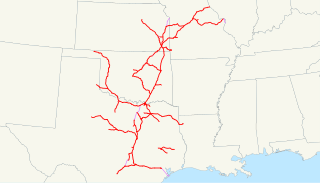
The Missouri–Kansas–Texas Railway is a former Class I railroad company in the United States, with its last headquarters in Dallas. Established in 1865 under the name Union Pacific Railway, Southern Branch, it came to serve an extensive rail network in Texas, Oklahoma, Kansas, and Missouri. In 1989, it merged with the Missouri Pacific Railroad; today, it is part of Union Pacific Railroad.

The St. Louis–San Francisco Railway, also known as the Frisco, was a railroad that operated in the Midwest and South Central U.S. from 1876 to April 17, 1980. At the end of 1970 it operated 4,547 miles (7,318 km) of road on 6,574 miles (10,580 km) of track, not including subsidiaries Quanah, Acme and Pacific Railway or the Alabama, Tennessee and Northern Railroad; that year it reported 12,795 million ton-miles of revenue freight and no passengers. It was purchased and absorbed into the Burlington Northern Railroad in 1980. Despite its name, it never came close to San Francisco.

The Wichita, Tillman and Jackson Railway is a shortline railroad subsidiary of the Rio Grande Pacific Corporation that operates two disconnected lines in Oklahoma and Texas, mostly owned by the state of Oklahoma. The line for which it is named extends from Wichita Falls, Texas to Altus, Oklahoma, through Wichita, Tillman, and Jackson Counties. It was completed by the Wichita Falls and Northwestern Railway and Wichita Falls and Northwestern Railway of Texas in 1910, and became part of the Missouri, Kansas and Texas Railway (MKT) system in 1911. The line was cut back from Forgan, in the Oklahoma Panhandle, to Altus in 1973, and operations were transferred to the WTJR in January 1991. The other line, from Waurika to Walters, is a former Chicago, Rock Island and Pacific Railroad branch, leased to the Oklahoma, Kansas and Texas Railroad, an MKT subsidiary, after the Rock Island's abandonment in 1980, and transferred to the WTJR in 1991.
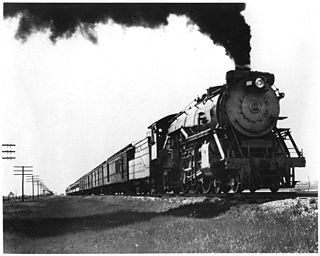
The Fort Worth and Denver Railway, nicknamed "the Denver Road," was a Class I American railroad company that operated in the northern part of Texas from 1881 to 1982, and had a profound influence on the early settlement and economic development of the region.
Article X of the Texas Constitution of 1876 covers railroad companies and the creation of the Railroad Commission of Texas. The federal government later created the Interstate Commerce Commission to regulate railroads, and eight of the nine sections of Article X were repealed in 1969 as "deadwood".
Frank Kell Cahoon, Sr., was an oilman and natural gas entrepreneur from Midland, Texas, who was the only Republican member of the Texas House of Representatives in the regular 1965 legislative session. Cahoon served two terms in the legislature from 1965 to 1969.
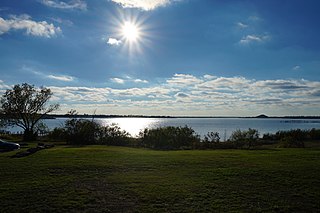
Lake Wichita was a large man-made lake of 2,200-acre (890 ha) acres located some three miles southwest of Wichita Falls, Texas. Its creation was primarily the work of the business entrepreneur Joseph A. Kemp, who with his brother-in-law Frank Kell, is considered one of the principal founders of Wichita Falls in the early 20th century. In 1995, the dam and spillway were rebuilt lowering conservation elevation to 976', decreasing surface acreage to 1224 acres at full pool, and leaving average depth of four feet.
The Wichita Falls and Northwestern Railway was among several short-line railroads which in the first half of the 20th century extended like the spokes of a wheel from the hub city of Wichita Falls, Texas. Its principal owners were the entrepreneurs Joseph A. Kemp and his brother-in-law, Frank Kell.
The Clinton-Oklahoma-Western Railroad Company of Texas was a 56-mile length of railroad track extending from the Oklahoma state line in eastern Hemphill County, Texas, to Pampa, the county seat of Gray County, located northeast of Amarillo. Chartered in 1927, the COW-T was an extension of another entity, the Clinton and Oklahoma Western Railroad Company, which operated from Clinton, Oklahoma, west to the Hemphill County line near Canadian, Texas. With an initial investment of $100,000, the COW-T business office was located at Wichita Falls, Texas.
The San Antonio, Uvalde and Gulf Railroad was a South Texas railroad company in the first half of the 20th century that linked San Antonio with Corpus Christi, Texas. Chartered in 1909 as the Crystal City and Uvalde Railroad, it was renamed in 1912. Because of its unusual abbreviation, the SAU&G, the railroad was for years thereafter popularly called "The Sausage".
The Missouri and North Arkansas Railroad was a regional carrier from 1906 to 1946, which at its peak strength joined Joplin in southwestern, Missouri with Helena in Phillips County in eastern Arkansas.



